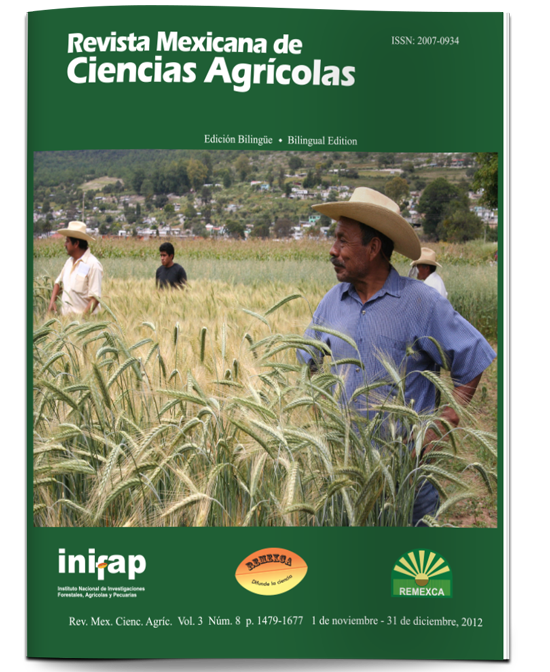Yield of bean genotypes with different sowing, irrigation-drought methods in Aguascalientes
DOI:
https://doi.org/10.29312/remexca.v4i8.1134Keywords:
Phaseolus vulgaris L., plant density, drought resistance, yieldAbstract
In Mexico, beans (Phaseolus vulgaris L.) are grown mainly in poor rainfed environments, where drought cause low grain yields. We evaluated grain yield of ten bean genotypes under three planting methods and number of plants per hectare: a) furrow at 0.76 m in a single row (90 000 pl ha-1); b) beds in 1.52 m with three rows (145 000 pl ha-1) and; c) beds of 1.52 m with six rows (260 000 pl ha-1) and two humidity conditions: Rainfed (T) and Rainfed plus two supplementary irrigations (T+RS) applied in the reproductive phase. The materials used were: type Pinto (Centauro, Libertad, Centenario, Saltillo, Bravo and Coloso); Flor de Mayo (Guanajuato, Dolores and Eugenia) and; Azufrado. The experiment was located in Pavilion and Sandovales, Aguascalientes; sowing was on July 31th and August 1th , 2012. The drought susceptibility index (ISS) was estimated between both humidity conditions. Sowing methods significantly (p< 0.01) affected the yield in both humidity conditions, being the highest with six rows, followed by the one with three rows and finally the single row, with yields of 2.94, 2.18 and 1.72 t ha-1 for T + RS and 1.14, 0.93 and 0.71 t ha-1 for T, respectively. The response of the genotypes was significant (p< 0.01), outstanding Pinto Centauro and Libertad (2.70 and 2.65 t ha-1) with T+RS and Pinto Saltillo (1.06 t ha-1) in T, respectively. Based on the yield reduction and ISS, all genotypes were moderately drought tolerant.
Downloads
Downloads
Published
How to Cite
Issue
Section
License
The authors who publish in Revista Mexicana de Ciencias Agrícolas accept the following conditions:
In accordance with copyright laws, Revista Mexicana de Ciencias Agrícolas recognizes and respects the authors’ moral right and ownership of property rights which will be transferred to the journal for dissemination in open access. Invariably, all the authors have to sign a letter of transfer of property rights and of originality of the article to Instituto Nacional de Investigaciones Forestales, Agrícolas y Pecuarias (INIFAP) [National Institute of Forestry, Agricultural and Livestock Research]. The author(s) must pay a fee for the reception of articles before proceeding to editorial review.
All the texts published by Revista Mexicana de Ciencias Agrícolas —with no exception— are distributed under a Creative Commons License Attribution-NonCommercial 4.0 International (CC BY-NC 4.0), which allows third parties to use the publication as long as the work’s authorship and its first publication in this journal are mentioned.
The author(s) can enter into independent and additional contractual agreements for the nonexclusive distribution of the version of the article published in Revista Mexicana de Ciencias Agrícolas (for example include it into an institutional repository or publish it in a book) as long as it is clearly and explicitly indicated that the work was published for the first time in Revista Mexicana de Ciencias Agrícolas.
For all the above, the authors shall send the Letter-transfer of Property Rights for the first publication duly filled in and signed by the author(s). This form must be sent as a PDF file to: revista_atm@yahoo.com.mx; cienciasagricola@inifap.gob.mx; remexca2017@gmail.
This work is licensed under a Creative Commons Attribution-Noncommercial 4.0 International license.



